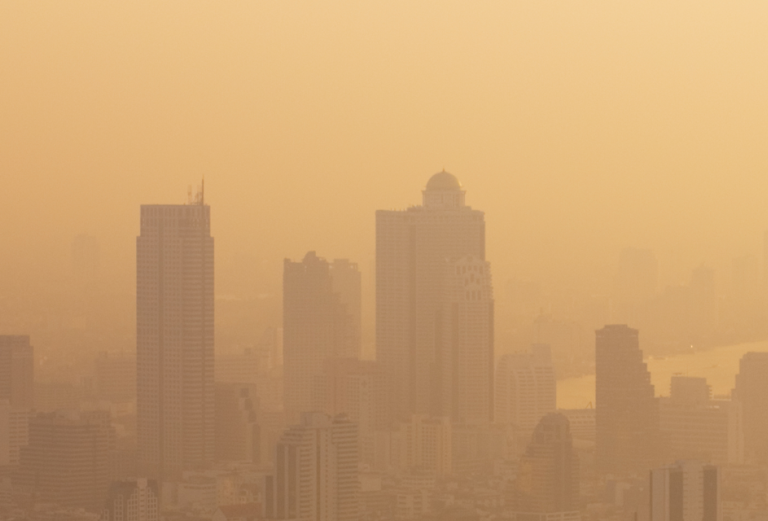Particulates that Matter
Small airborne particles cause big problems, and some populations breathe in an unequal share
- 5 minute read
- Climate in the Clinic

To breathe is to live, but what if the air you breathe isn’t clean?
Each year, outdoor and indoor air pollution together kill seven million people, according to a 2012 report from the World Health Organization. In the 1990s, the landmark Harvard Six Cities Study found that living in cities choked with air pollution reduces life expectancy by two to three years.
Most air pollution-induced sickness and mortality can be traced to particulates. No larger than 10 microns, or the size of a dust mote, these solid particles and liquid droplets slip through the body’s initial filters and clog its airways. Exposure to them can cause asthma, chronic bronchitis, chronic obstructive pulmonary disease, and lung cancer. Particulates under 2.5 microns, or PM 2.5, such as flecks of soot, can permeate the bloodstream, leading to stroke, heart attack, and changes in blood pressure and cholesterol levels.
Doctors and researchers are still learning how far the effects extend. Exposure to fine particulates during pregnancy appears to raise the risk of premature birth, maternal and fetal death, and, in children, autism. Studies suggest that PM 2.5 can hinder children’s neurological development, contribute to type 2 diabetes, and speed cognitive decline in the elderly. Genetic and immunological underpinnings are still being unraveled.
The burdens of unclean air are not distributed equally. Most at risk are the young, the old, and those with underlying health conditions. Vulnerability also is heightened among those who work outdoors, are poor, or belong to a historically marginalized group, particularly Black, Hispanic, and Indigenous people—likely because of circumstance, not biology.
Contributing factors can be hard to disentangle. People with low incomes are more likely than affluent people to have no choice but to live near pollution sources, whether those sources are industrial emissions in inner-city neighborhoods or mining dust on Native American reservations. Centuries of structural racism in the United States mean that those with low incomes are more likely to be people of color and that people of color are less able to access quality health care and more likely to have underlying or uncontrolled health conditions than white people.
“The health inequities mirror the environmental inequities,” says Jonathan Gaffin, MMSc ’11, an HMS assistant professor of pediatrics and co-director of the Severe Asthma Program at Boston Children’s Hospital.
No escape
Gaffin and colleagues, including Wanda Phipatanakul, an HMS professor of pediatrics at Boston Children’s, and Diane Gold, an HMS professor of medicine at Brigham and Women’s Hospital, have spent years investigating the nature and effect of air pollutants on urban residents in the northeastern United States. They’ve collaborated on testing air-cleaning interventions and quantifying specific air pollutants, such as PM 2.5, in homes and schools and tying them to health outcomes in children.
In doing so, the team has helped show that people can’t always escape outdoor pollution by going inside. Particulates and other pollutants seep through cracks and vents, and buildings can produce their own particulates, such as those from decaying infrastructure. Some pollutants can become even more concentrated indoors.
Air pollution and climate change represent two heads of the same beast. Both are produced during the burning of fossil fuels. Some particulates cloud the air with greater frequency and density as climate change whips up storms, droughts, and other extreme weather events.
“The good news is that since the evil twins of climate change and air pollution share a common source, any action to control one will control the other,” says Philip Landrigan, MD ’67, director of the Global Public Health Program and Global Pollution Observatory at Boston College and an HMS adjunct professor of environmental health.
Physician power
Clinicians have at least three routes open to effect change that could benefit patients.
First, they can educate themselves about the potential contributions of air pollutants to their patients’ acute and chronic health problems. They can recommend evidence-based interventions such as refraining from outdoor exercise on days with bad air quality, using cleaner heating or cooking fuels, or, if feasible, installing home air filters or moving from pollution-heavy neighborhoods.
“Air pollution should enter the doctor-patient conversation alongside our traditional focus on personal behaviors,” says Landrigan.
Gold emphasizes the importance of providing information to empower vulnerable patients as well as families, community members, and government officials. She co-authored an article on air pollution, climate change, and heart disease in 2013 that offers advice to patients and health care providers.
Second, clinicians can engage in studies. Gold and colleagues have linked PM 2.5 exposure to increases in blood pressure and higher risk of cardiac arrhythmias in people with heart disease. Gaffin is investigating whether indoor air pollution contributes to respiratory symptoms and diminished lung function in children with bronchopulmonary dysplasia who were born prematurely. Pulmonologist Mary Rice, MD ’07, an HMS assistant professor of medicine at Beth Israel Deaconess Medical Center, has studied particulates and found that long-term exposure to traffic pollution may reduce lung function as much as smoking does. She’s now exploring whether reductions in particulates improve COPD and whether high temperatures exacerbate the effects of particulates.
Third, clinicians can become advocates. Reducing air pollution and tackling climate change require large-scale efforts, and political activism offers opportunities to contribute. Rice has testified before Congress and the U.S. EPA and chairs the American Thoracic Society’s Environmental Health Policy Committee. And Landrigan, who helped get lead removed from gasoline and paint in the United States in the 1970s, now focuses on pollution and climate change and is urging leaders of developing nations to forgo fossil fuel-based development and move directly to renewable energy sources.
Stephanie Dutchen is a science writer in the HMS Office of Communications and External Relations.
Image: plherrera/Getty Images